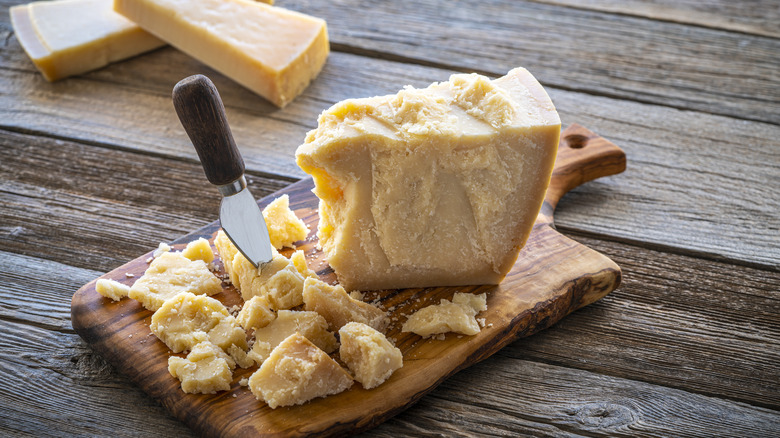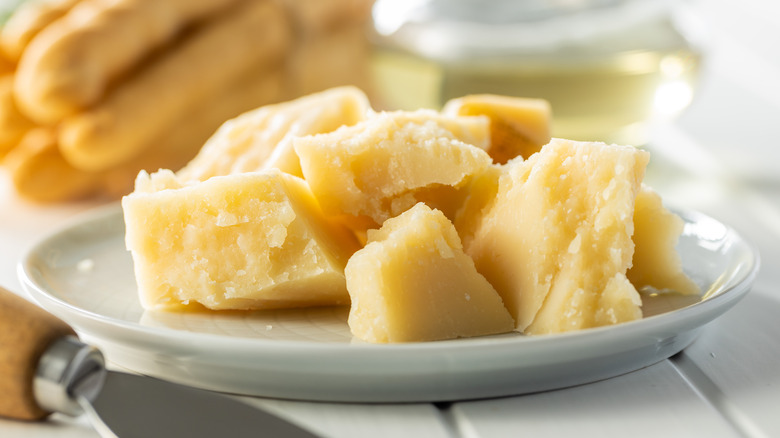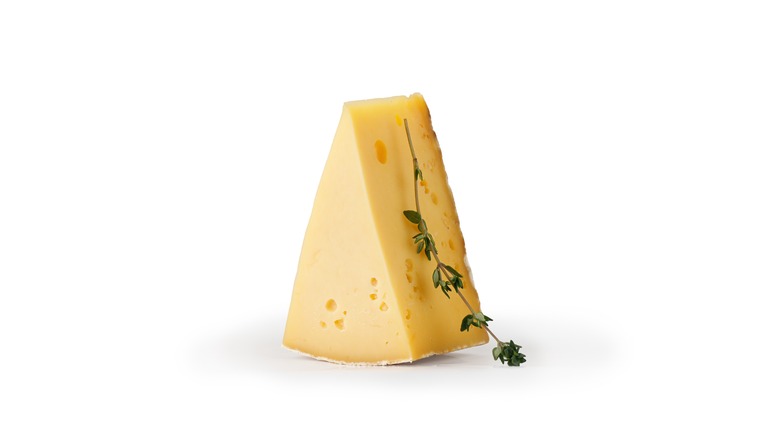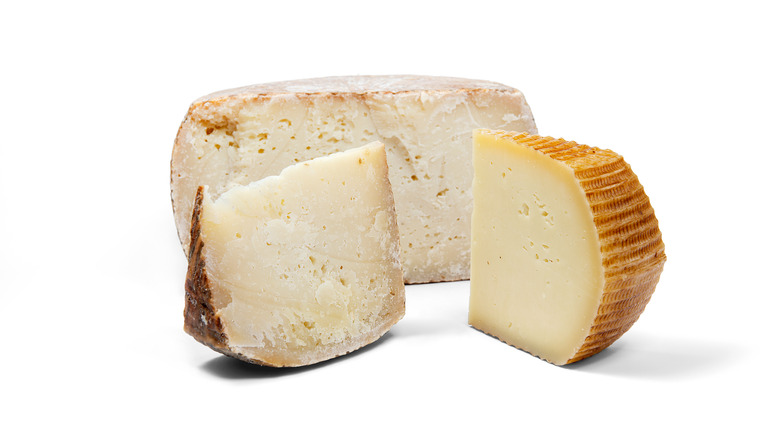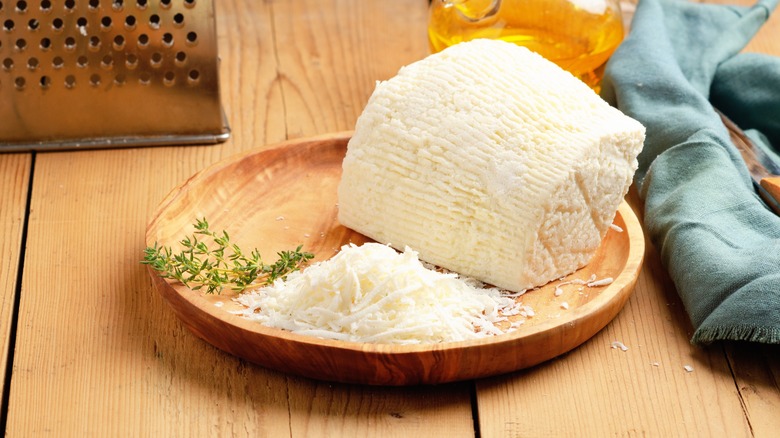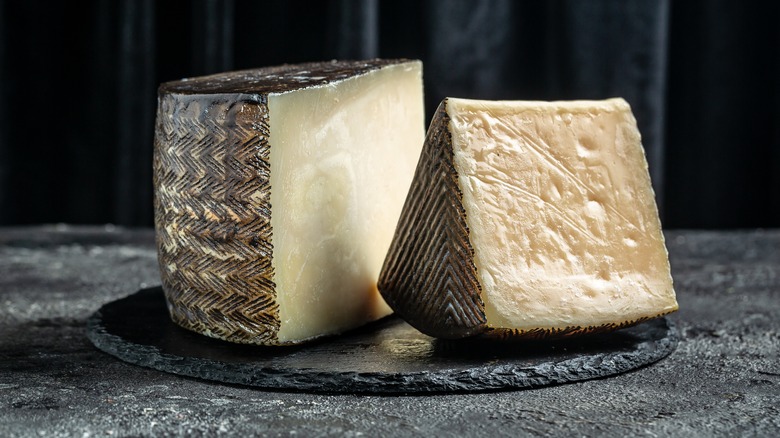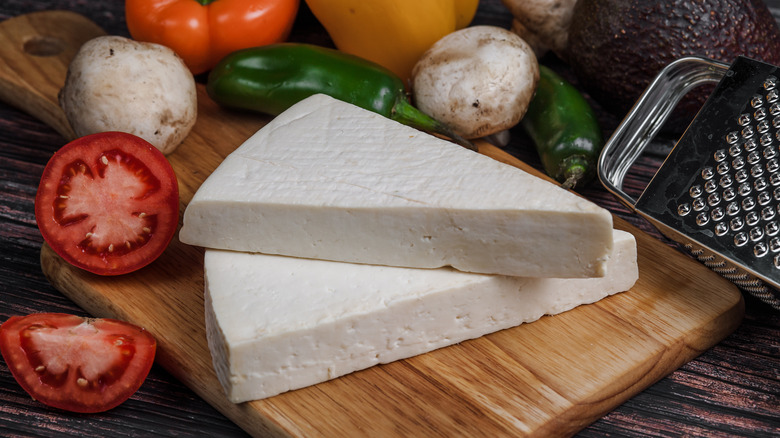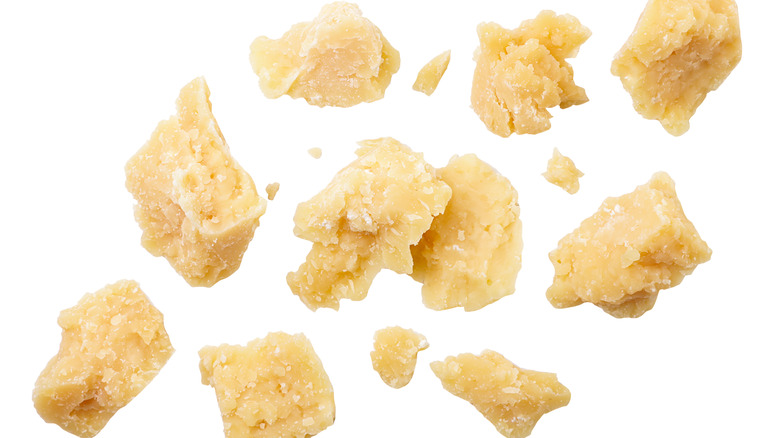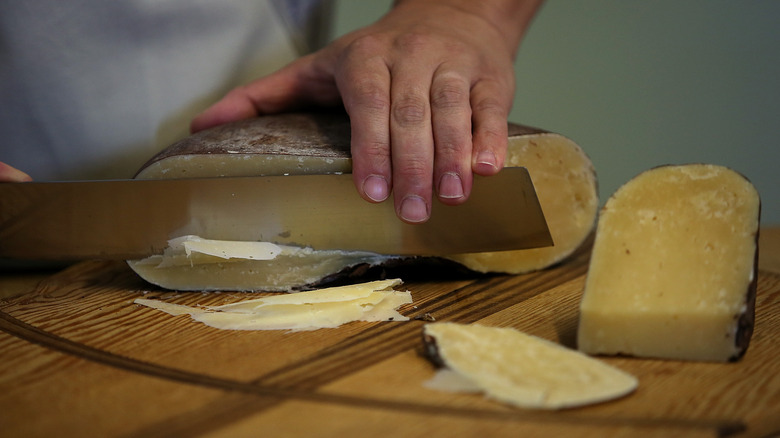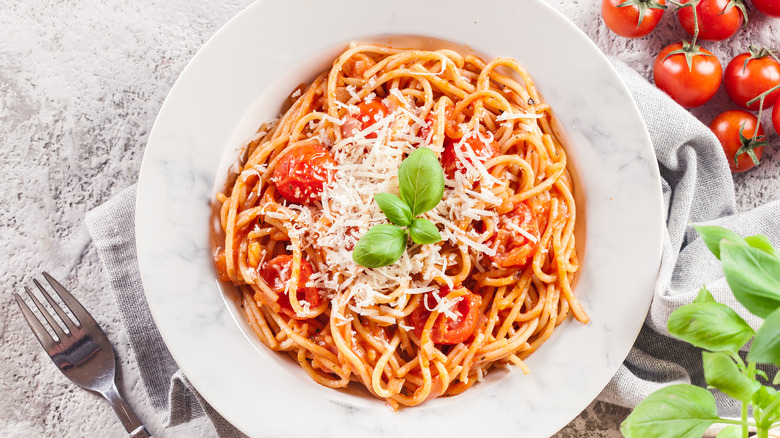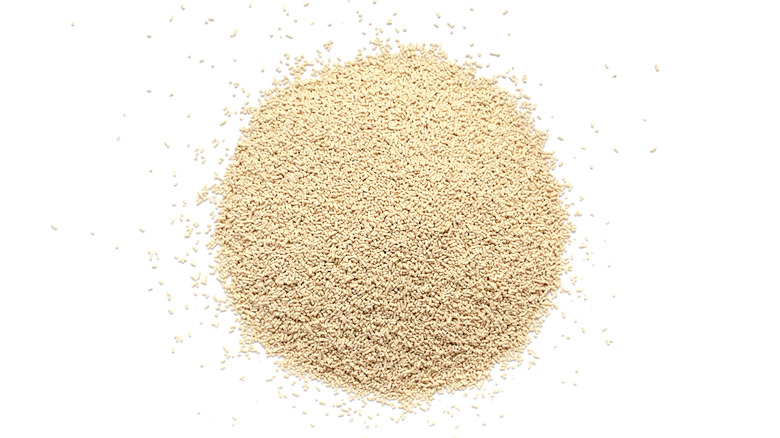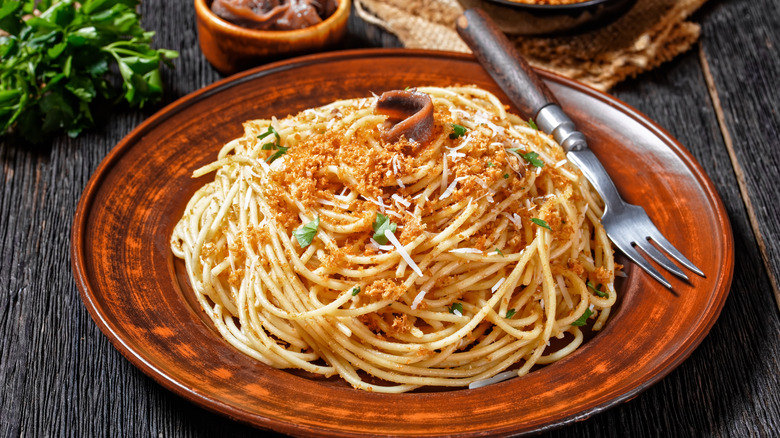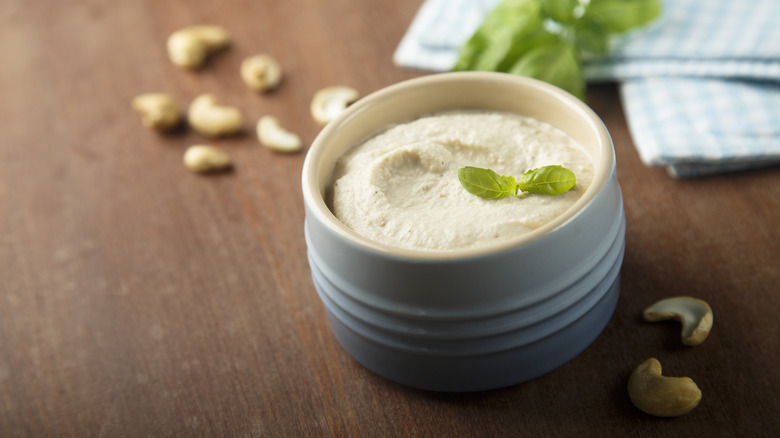12 Best Ingredient Swaps For Parmesan Cheese
Parmigiano Reggiano is one of the most prized dairy products in the world. The rich, unique flavor, crumbly texture, and careful traditional techniques ranging from the cows' diet to the aging process all contribute to a fantastic taste experience. The use of the name Parmigiano Reggiano refers to specific cheese made in several provinces in Northern Italy is strictly regulated. The difference between Parmigiano and Parmesan is that Parmesan is an English translation of the Italian word Parmigiano and, while it may be used for the genuine Italian cheese, it's usually used to label imitation cheeses with a similar taste and texture, but which are unregulated and can be made anywhere in the world.
Whether it's Parmigiano or Parmesan (and we'll use the word Parmesan to refer to this type of cheese in general in this article), this product is widely used to add a creamy, salty, nutty, toasty, or crunchy final touch to many kinds of pastas, risottos, salads, and baked dishes, as well as being enjoyed alone. But sometimes Parmesan is not available. Perhaps it's out of budget, you've run out and can't get to the store, you'd like to experiment with other ingredients, or you are looking for a dairy-free alternative. Whatever the reason, there are many options for substitutes that will work well in a variety of dishes like chicken Parmesan, eggplant Parmesan, and Parmesan risotto.
1. Grana Padano
Grana Padano is a hard cheese produced in northeastern Italy that is aged for a minimum of nine months and made from part-skim milk. It was originally made in the 1100s by monks in the region of Marche. It has a whitish color and a grainy texture — in fact, the word "grana" is an Italian noun meaning "grainy." While less expensive than Parmigiano Reggiano, Grana Padano is not inferior. It is made by skilled artisans following strict traditional methods, uses milk from free-range cows eating a pure diet, and is carefully inspected and marked before sale. Like Parmigiano Reggiano, this cheese has also been awarded the Denominazione di Origine Protetta (Protected Designation of Origin) classification, marking it as a high-quality product.
The nutty, creamy taste of Grana Padano is similar to that of Parmigiano Reggiano, although Grana is a little less crumbly and strong. It can be used in all the same ways that Parmesan can. Sprinkle it on pasta, risotto, or soup, use it in baked pasta dishes, or eat it alone or as part of an appetizer buffet.
2. Asiago
Asiago is an Italian cheese made in the regions of Veneto and Trentino-Alto Adige of northeastern Italy. The Asiago made in this area carries the DOP classification, and its production dates back over a millennium.
Modern Asiago is made from cow's milk but was originally a sheep's milk cheese. There are two main types of Asiago, and the taste, texture, and color depend on how long it was aged. Asiago Pressato is a fresh cheese with a sweeter, milder taste and a smoother texture. The color is close to white. This is more similar to mozzarella than Parmesan and is ideal for slicing and melting.
The kind of Asiago that works well as a substitute for Parmesan is Asiago d'Allevo, and the various versions have a dark yellow color and are aged between four months and two years. These aged varieties are hard and crumbly and have a sharper, nuttier flavor than their fresh counterparts. You can use aged Asiago just like you would use Parmesan. Grate it on pasta or soup, melt it in the oven, add it to salads, or simply enjoy it alone.
3. Pecorino
Like Parmigiano Reggiano, pecorino is also a hard, aged Italian cheese, but it's made from sheep's milk instead of cow's milk ("pecora" means "sheep" in Italian). Pecorino can be a great substitute for Parmesan cheese, although the flavor of pecorino is less similar to Parmesan than the flavor of Grana Padano. It has a much sharper taste, as well as a higher fat and salt content. The cheese is really quite salty, so be mindful not to oversalt any dishes you make with it.
There are different kinds of pecorino, and they are named after the location they originate from. Many people are familiar with Pecorino Romano, which has ancient Roman origins and is the best-known Italian cheese abroad. Today, although some pecorino comes from Sicily or Tuscany, Sardinia is responsible for most of its production nowadays.
If you can find it, don't miss the chance to try Pecorino Fiore Sardo, a special kind of pecorino made from the milk of Sardinia's native sheep breed and first made in the Bronze Age. This semi-hard, raw cheese made from whole milk is aged for eight months before being smoked slightly. Rich and grainy, it can be enjoyed alone, grated onto dishes, or used in any other way that Parmesan can.
4. Ricotta salata
Ricotta salata is a firm, aged version of ricotta made in southern Italy. While not as well known or easy to find as fresh ricotta, which is moist and creamy, ricotta salata is dry and has a delicious, slightly briny, and very salty taste that is worth trying. Fresh ricotta can be made from either cow's milk or sheep's milk, but ricotta salata is usually made from sheep's milk. Both have a bright milky white color.
Ricotta salata is made using the same process as fresh ricotta, but more steps are added at the end when the pressed curds are salted and aged for 10 to three months. The process gives the cheese its name, since "salata" means "salted" in Italian.
This hard cheese is crumbly and can be sliced and eaten alone or grated and used like Parmesan. It can be baked in a timballo, baked pasta dish, or quiche, grated on top of pasta or pizza, or sliced and eaten alone as part of an appetizer or cheese board. Some people prefer ricotta salata because it has fewer calories than more common grating cheeses, but keep in mind that it has a higher calorie content than fresh ricotta since it contains less water.
5. Manchego
Manchego is a Spanish cheese made from the milk of Manchega sheep, which live in the wild La Mancha area in the center of the country. The region's inhabitants started making Manchego in prehistoric times. Modern Manchego can be industrial or artisanal. The artisanal cheese is made with raw sheep's milk instead of pasteurized milk.
Fresh Manchego is soft and delicious on its own, but aged Manchego is harder and is a better substitute for Parmesan. It has a lighter color than Parmesan, but the flavor is stronger, saltier, and more complex, and the aroma is more dynamic. To give it more flavor, Manchego is first submerged in brine and then covered in a coating of olive oil before being aged from two weeks minimum (for fresh varieties) to over a year. The longest-aged cheese will have a more developed flavor and a grainier and flakier texture.
Manchego is like a stronger cousin of Parmesan and can be used in any way Parmesan can. Some people especially appreciate it in baked dishes because of the added complexity of flavor it provides compared to Parmesan.
6. Cotija
Cotija is a firm, rindless Mexican cheese. The town of Cotija gives this unpasteurized cow's milk cheese its name. It has a bright white color, a strong salty flavor, and a round shape. Cotija belongs to the Parmesan family and the aged version, which is known as cotija añejo ("añejo" means mature in Spanish), is hard with a crumbly texture. This similarity to Parmesan has led to its nickname: the Parmesan of Mexico.
Make sure to choose aged cotija when using it as a substitute for Parmesan. Fresh cotija, while tasty, is not hard and doesn't crumble like Parmesan. Its texture is more similar to feta cheese. Keep in mind that aged cotija will behave differently than Parmesan. While it's delicious in baked or cooked dishes and will become warm and soft, the cheese won't lose its shape or melt when heated, so you can add it at the end. Grate, slice, or crumble cotija and use it any way you would use Parmesan. Another great way to enjoy it is with Mexican dishes like tacos, elotes, burritos, quesadillas, and enchiladas.
7. Reggianito
Reggianito comes from Argentina and is similar to Parmigiano Reggiano because it was created by Italians. After the First World War, these immigrants created a replacement for their beloved cheese in their new country. Fittingly, the name Reggianito is a Spanish diminutive of the word Reggiano and refers to the smaller size of Reggianito cheese wheels compared to the larger Italian wheels of Parmigiano Reggiano. It is made with either unpasteurized or pasteurized cow's milk and aged for six months.
While only Parmigiano Reggiano has protected DOP status, which it was understandably granted to protect an authentic product from a similar competitor, Reggianito is very similar to Parmigiano and is closer to the Italian cheese than to other Argentinian foods. The color of straw, it boasts a salty, full-bodied taste akin to Parmigiano. And like the original, it has a hard, crumbly granular texture and is ideal for grating or cutting into chunks. Use Reggianito like you would any Parmesan.
8. Dry Jack
Dry Jack is an American cheese in the Monterey Jack family made from pasteurized cow's milk. This firm version of Monterey Jack has quite interesting origins. It was developed by chance in the early 1900s when fresh Monterey Jack was left unsold and ultimately forgotten by a wholesaler. Years later it was found and discovered to be a delicious aged cheese that was extremely popular with consumers.
While at first Monterey Jack may not seem like a good alternative to Parmesan, Dry Jack is different because it is an aged version of the cheese. The maturation process lasts at least seven to 10 months, but some kinds are aged for up to four years. This aging intensifies the flavor and transforms it from mild to rich and nutty, and it develops a strong aroma. The texture changes from soft and creamy to hard, brittle, and crumbly like Parmesan, and there may be small holes in it. The color is light yellow. Dry Jack can replace Parmesan in any dish, and it is an especially good choice for melting.
9. Vegan Parmesan
Traditional Parmesan made from milk is a prized product, but not everyone wishes or is able to eat dairy. Whether for ethical, sustainability, or health reasons, reaching for plant-based alternatives to classic foods like cheese is becoming more widespread. The good news is that those looking for an alternative to Parmesan have options. One choice that looks surprisingly like the original is vegan Parmesan. It's straw-colored and sold shaved or in hard wedges. Some kinds are made from soy, while others use different ingredients. For example, the main ingredients of Violife's plant-based Parmesan are potato and rice starch, coconut oil, salt, rice protein, vegan flavoring, and filtered water.
While it's inevitable that there will be differences in the flavor, this alternative cheese has both a mild and nutty flavor and a texture reminiscent of Parmesan. In terms of nutrition, a one-ounce serving of Violife's product has 80 calories and five grams of fat compared to the original's 111 calories and 10 grams of fat in a serving of the same size. Unless you choose a soy version, this food is not a good source of protein, but it is cholesterol free.
10. Nutritional yeast
Nutritional yeast is a type of Saccharomyces cerevisiae, an ancient yeast species, and it is used as a nutritional supplement or to add flavor to food. It is rendered inactive after undergoing a heat drying process, which means it's not a living form of yeast like baker's yeast and cannot leaven bread or influence yeast infections. Also known as nooch, nutritional yeast is popular in the vegan community as a replacement for cheese, because many people consider its savory nutty flavor to be reminiscent of Parmesan. It's also appreciated for its high levels of B vitamins, including B12, which vegans need to supplement.
Parmesan can be substituted with nutritional yeast in several ways. The easiest way is to sprinkle the dry flakes on top of your dish as you would with cheese. You can also use it to make a hot, melty, dairy-free cheese sauce for baked and cooked dishes like macaroni and cheese and cheesesteaks. Alternatively, you can combine it with other ingredients to make a flavorful grated cheese substitute. One way to do this is to combine nutritional yeast, cashews or other nuts, garlic powder, and salt in a food processor and pulse until it resembles the texture of grated cheese.
11. Breadcrumbs
Breadcrumbs may seem like an unusual Parmesan substitute, and even though they don't taste like cheese, they can add flavor and a crunchy texture to dishes just like cheese does. A simple way to use breadcrumbs in this way is to toast them in a pan with a bit of olive oil. Once they're hot and browned, sprinkle them on top of pasta. In fact, many Italian pasta dishes call for toasted breadcrumbs on top. This is especially true for fish pasta because Italians don't put cheese on fish. You can use this technique for vegetable pasta recipes too.
Another way to use breadcrumbs to replace Parmesan is by combining them with other ingredients to make a gremolata topping. Mix breadcrumbs with finely minced garlic, chopped parsley, and salt for a simple but deeply flavorful combination. You can add other ingredients like freshly grated lemon zest for added zing. Unless you toast the breadcrumbs first, use the gremolata in dishes that will go in the oven so the topping will become crispy and toasted. Spread it on fish before baking, or sprinkle it atop of baked pasta dishes or stuffed peppers before popping them in the oven.
12. Nuts and seeds
Just like breadcrumbs, nuts and seeds can be used to replace Parmesan and add a crunchy topping to pasta and baked dishes. Pulse any nuts or seeds you like in a food processor until they reach a fine grainy texture similar to grated cheese. Almonds, cashews, walnuts, or hazelnuts are good choices and so are hemp seeds, sunflower seeds, and pumpkin seeds. You can sprinkle this directly on your pasta or toast it first in a small amount of olive oil until warm and crispy.
Combine the pulsed nuts or seeds with flavorful ingredients like garlic, parsley, and salt to make a topping you can sprinkle on dishes before baking. The result will be a satisfyingly toasty bite that's also gluten and dairy free, making it an ideal substitution for those who don't eat cheese or breadcrumbs.
You can even use cashews to replace Parmesan in melted cheesy toppings. All you have to do is soak raw cashews in water for half an hour, drain, and blend with water for about a minute in a blender until very smooth. The resulting cashew cream is combined with spices or other ingredients to make a creamy base for vegan macaroni and cheese, nacho sauce, and other kinds of hot dishes.
